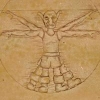...well, I was curious, so I googled a bit (btw, what the OP should have done!)
Here are some excerpt from forum posts I found:
CryEngine
The practical maximum map size for a Cryengine 3 game is 4096m x 4096m - technically you can make terrains bigger than that but you'll start experiencing memory issues at larger sizes. There is a way to work around this limitation by building the actual terrain of the map from externally modeled meshes instead of the built-in terrain tools (a user called cwright has managed to build a working flight sim game spanning hundreds of kilometers across) but you'll start to experience precision problems such as player camera vibration, fog flickering etc at large distances from the map origin.
UDK
At 1uu == 1cm the physical limits of actor movement, collision and physics are 27 square kilometers. The physics of a map max out at 524,288 uu, beyond that only PHYS_None will work. Additionally you can encounter visual artifacts due to float imprecision as you approach that boundary.
...it's likely both engine have their limits about open worlds. Such maps are already huge. If you need to grow bigger, perhaps there are some workarounds, perhaps not.










